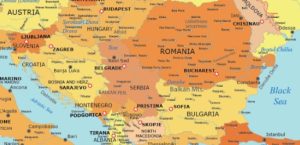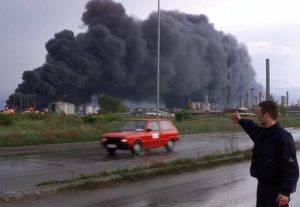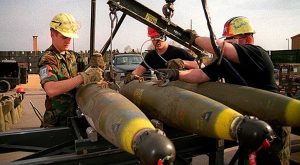
Balkans Environmental Disaster Zone
Nezavisimoye Voyennoye Obozreniye (Moscow) June 4-10, 1999
by Vladimir Mukhin

As a result of missile and bomb strikes by NATO aviation in Yugoslavia there have already been 30 incidents at chemical facilities involving leakage of dangerous components (vinylchloride monomer, ethylene, chlorine, hydrogen chloride, nitrogen-containing compounds, etc.), necessitating quick evacuation of more than 70,000 people from the danger zones.
Major-General Boris Alekseyev, chief of the Environmental Safety Directorate of the RF Ministry of Defense, said that especially significant damage to the natural environment was inflicted in the vicinity of Belgrade, where most of Yugoslavia’s industrial enterprises are concentrated. Damage to them was accompanied by extensive contamination of the atmosphere, water basins, soil, and underground water by highly toxic and harmful substances, including ones like chlorine, its derivatives, acids, phenols, and so on (within a radius of from 50 to 100 km of each such damaged enterprise).

It was also noted that destruction of or damage to facilities of the oil, chemical, and coal complexes was accompanied by major fires releasing large quantities of soot containing heavy metals (lead, mercury), sulphur dioxide, nitric oxides, carbon monoxide, dioxins, and aromatic hydrocarbons into the atmosphere. Among the latter is a chemical in danger class 1 possessing carcinogenic properties–benzopyrine.
In this case hundreds of tonnes of toxic combustion products were raised to a height of 3,000 m, from where they dispersed across borders for distances of many hundreds of kilometers. As an example after NATO air strikes against Yugoslav oil facilities on 18-19 April, combustion products were carried by air masses across Belarus to Russian territory as far as Pskov and Smolensk in connection with the south and southwest winds prevailing at this time. If the bombing continues, repetition of
such events is extremely probable.
Furthermore, the spread of petroleum products and toxic substances to the Black Sea by way of the Danube presents a special danger to Russia and Ukraine. An oil slick 400 m wide and over 15 km long is now nearing its mouth.

According to General Alekseyev ammunition with a depleted uranium core is also being used in Yugoslavia. He cited data of British ecologists (Coghill Research Laboratories) in this case. According to their information the significant increase in radioactivity in Serbia, Macedonia, Montenegro, and especially Kosovo is alarming. This became possible following the use of 30-mm projectiles carried by American A-10A ground-attack aircraft and of Tomahawk cruise missiles. A Defense Department spokesman noted that the armor-piercing core of 30-mm projectiles is made from alloys of depleted uranium-238 (actually, nuclear fuel wastes). The core’s radioactivity is around 3.4 millicuries. Around 1,000 alpha-particles and 36,000 beta- particles are emitted from its surface every second. The projectile weighs around 400 grams, with the radioactive core comprising around 300 grams of this amount. Areas with a level of radioactive emission on the order of 10 milliroentgens per hour have been detected in places attacked by A-10A aircraft.
Around 3 kg of depleted uranium are used in cruise missile warheads. When this uranium hits the target, it transforms into an aerosol cloud that spreads a distance of up to 50 meters from the target. The flow of alpha-particles emitted by uranium-238 causes serious injury to exposed surfaces of the human body. In this case its vapors, which are highly toxic, cause irreversible injury to internal organs, primarily respiratory organs, which will subsequently lead to cancer. Severe tissue lacerations and radioactive contamination of the body are observed with wounds caused by this ammunition and its fragments. Changes appear on the skin approximately 80 hours after direct contact of people with fragments of projectiles and warheads.
General Alekseyev noted that use of ammunition containing depleted uranium harbors an extreme danger to health owing to long-term radioactive contamination of huge areas not only in Yugoslavia but also in many other European countries, which may have a negative effect, in particular, on agriculture in the particular region. He did not reject the theory that in the very near future, we’ll be hearing the news that there are no ecologically clean food products in Southern Europe, and that it would be better to import them from other regions of the world.
Thus a major environmental disaster is developing in the Balkans. While many countries are not yet cognizant of them, calculations show that the losses will be sizeable, and the consequences will be felt for many decades to come.